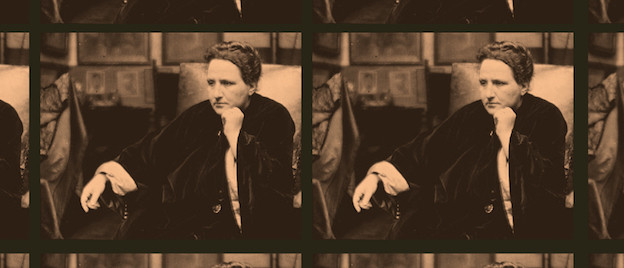Breed that

Tender Buttons is, famously, a text that deals with looking. As Stein details in her Lectures, the book is the result of her decision to “include what is seen with hearing and listening.”[1] The beautiful new edition accentuates this: it is the result of an act of scholarly scrutiny and its facsimile images, showing Stein’s corrections to the first edition, make it possible for everyone to experience the thrill of seeing Stein at work on her text. One of those images shows an inscription Stein added to Donald Sutherland’s first edition: “the concentration and the long struggle between sound sight sound and wide. and when it all came out so strangely” (84). As a comment, it shows Stein’s intention to emphasize sight over sound: sight should come first. As an image, of course, it stresses ‘sound.’ The image made me wonder about sound, and sound, in Tender Buttons,and about the book’s position in literary history.[2]
Speaking, or “talking and listening,” is what Stein herself associates with the portraits she wrote prior to Tender Buttons. Central to these pieces is a voice that says and says and says, capturing slightly different moments of being in a sequence of expressive sentences (“and each time I said what they were as they were, as I was, naturally more or less but never the same thing each time that I said what they were I said what they were”).[3] It is, however, the “breathless” Stein, the Stein who appears to delete ‘speaking’ from her poetic agenda when she starts writing Tender Buttons, that critics now put under the spotlight.[4] This modernist Stein seems to fall in between a romantic tradition, with poets intent on breathing the inhuman air of poetic truth, and a post-modern rediscovery of breath, with for example Charles Olson calling for a poetics of breath. Yet I’m unable to look at Tender Buttons as some kind of airtight autonomous construction. I see itas a book filled with breath, with sound that isn’t talk or music but the whizzing of energy being spent — with ‘sound’ first. After all, this is writing that deals with the joys of consuming. Its collection of objects and their many uses, the “excellent vapor” the food gives off (37), the eroticism, the open rooms with its currents indicate that this is modernist poetry that reinvents Wordsworth’s understanding of poetry as “an atmosphere of sensation.”[5] Stein constructs, rather than gains access to, her atmosphere. Notwithstanding many objections, from (poetic?) “declarations” to the state of the world (76), she takes care not to seal it off. Tender Buttons is Tender Buttons because “there is a chair and plenty of breathing.”
1. Gertrude Stein, “Portraits and Repetition,” in Writings 1932–1946, ed. Catharine Stimpson and Harriet Chessman (New York: Library of America, 1998), 302.
2. Thomas H. Ford, “Poetry’s Media,” NLH 44, no. 3 (2013): 449–469.
3. Stein, “Portraits and Repetition,” 299.
4. Lisa Siraganian, Modernism’s Other Work: The Art Object’s Political Life (Oxford: Oxford University Press, 2012).
5. William Wordsworth and Samuel Taylor Coleridge, “Preface,” in Lyrical Ballads (NY: Routledge, 2005), 302.